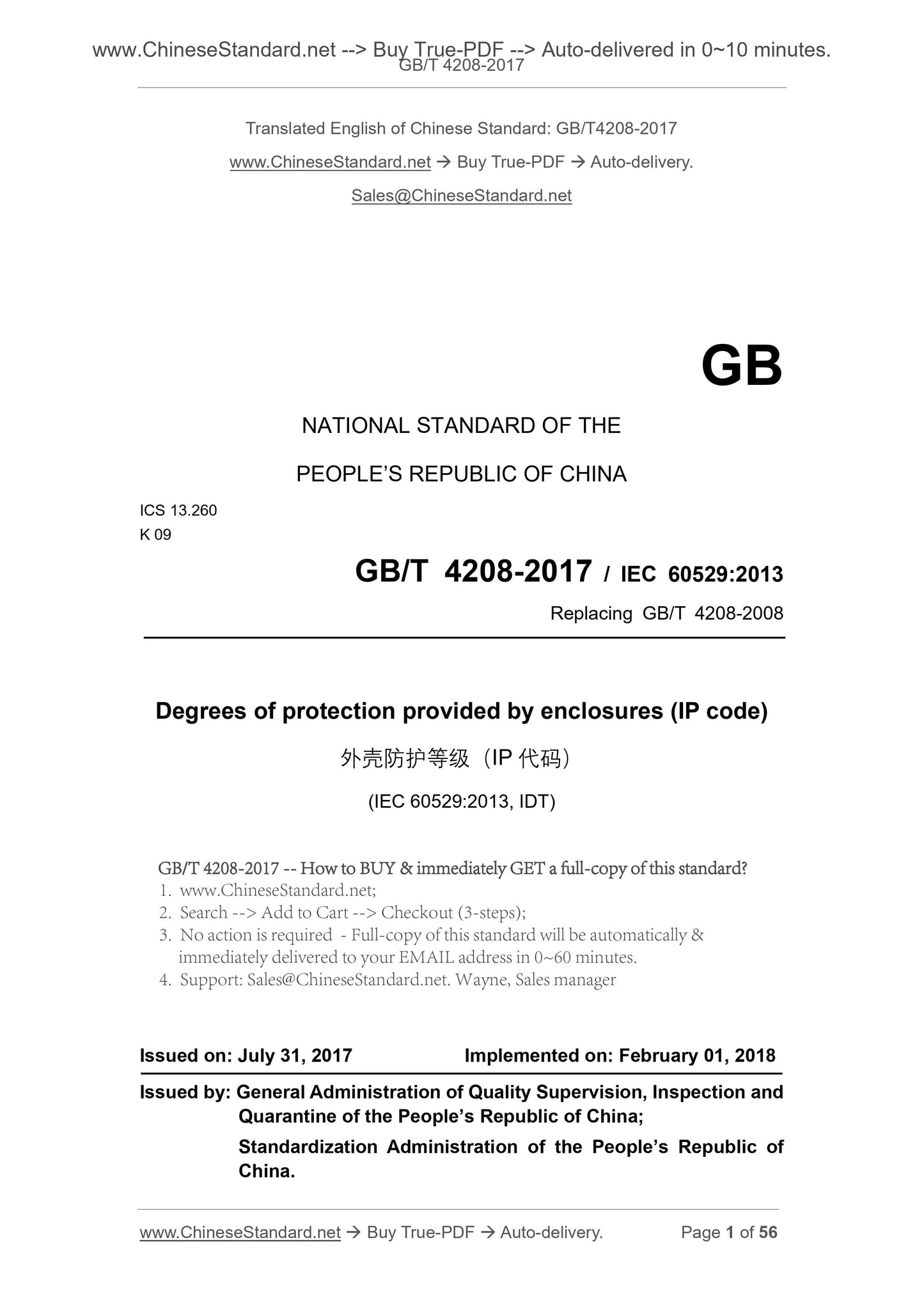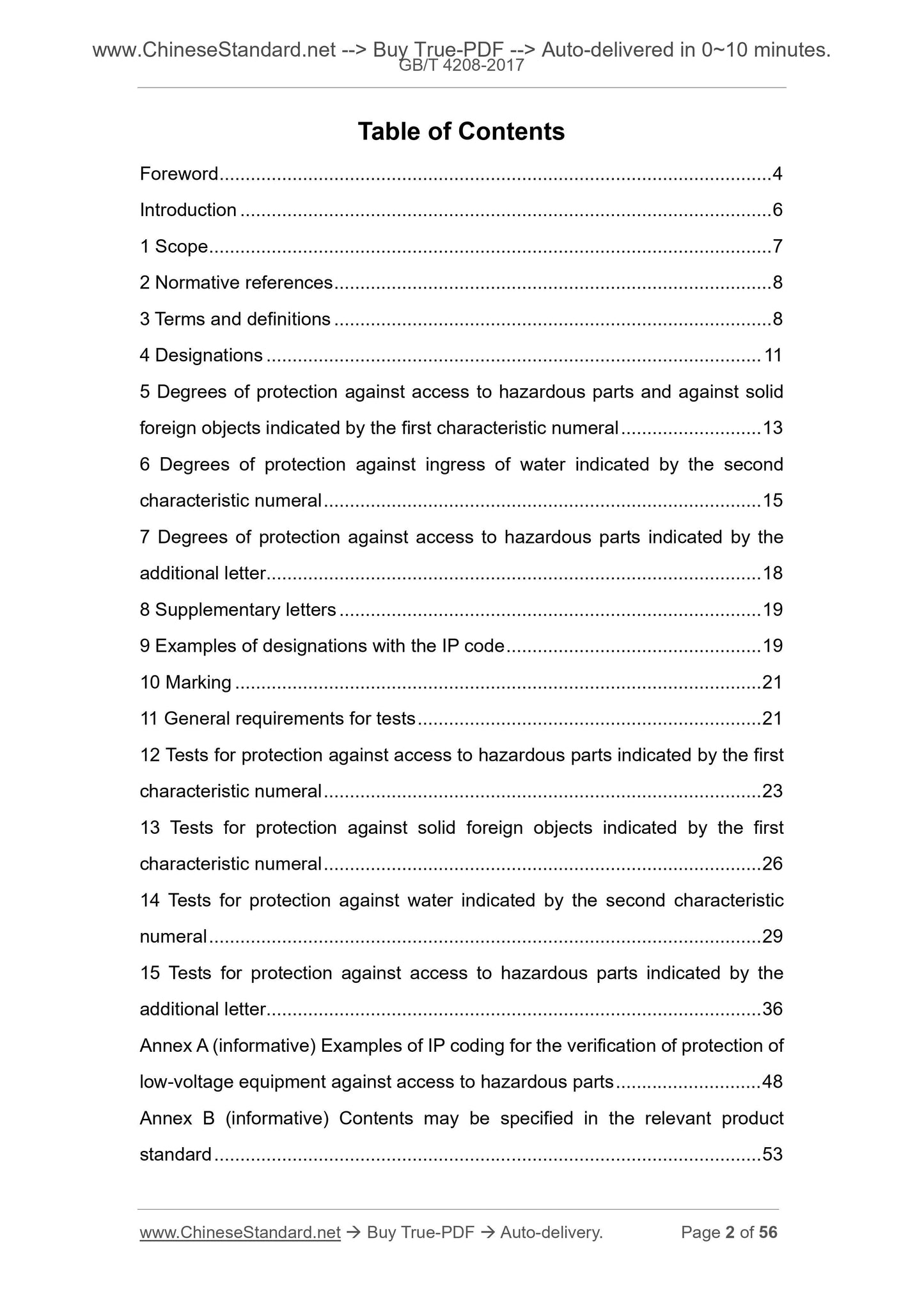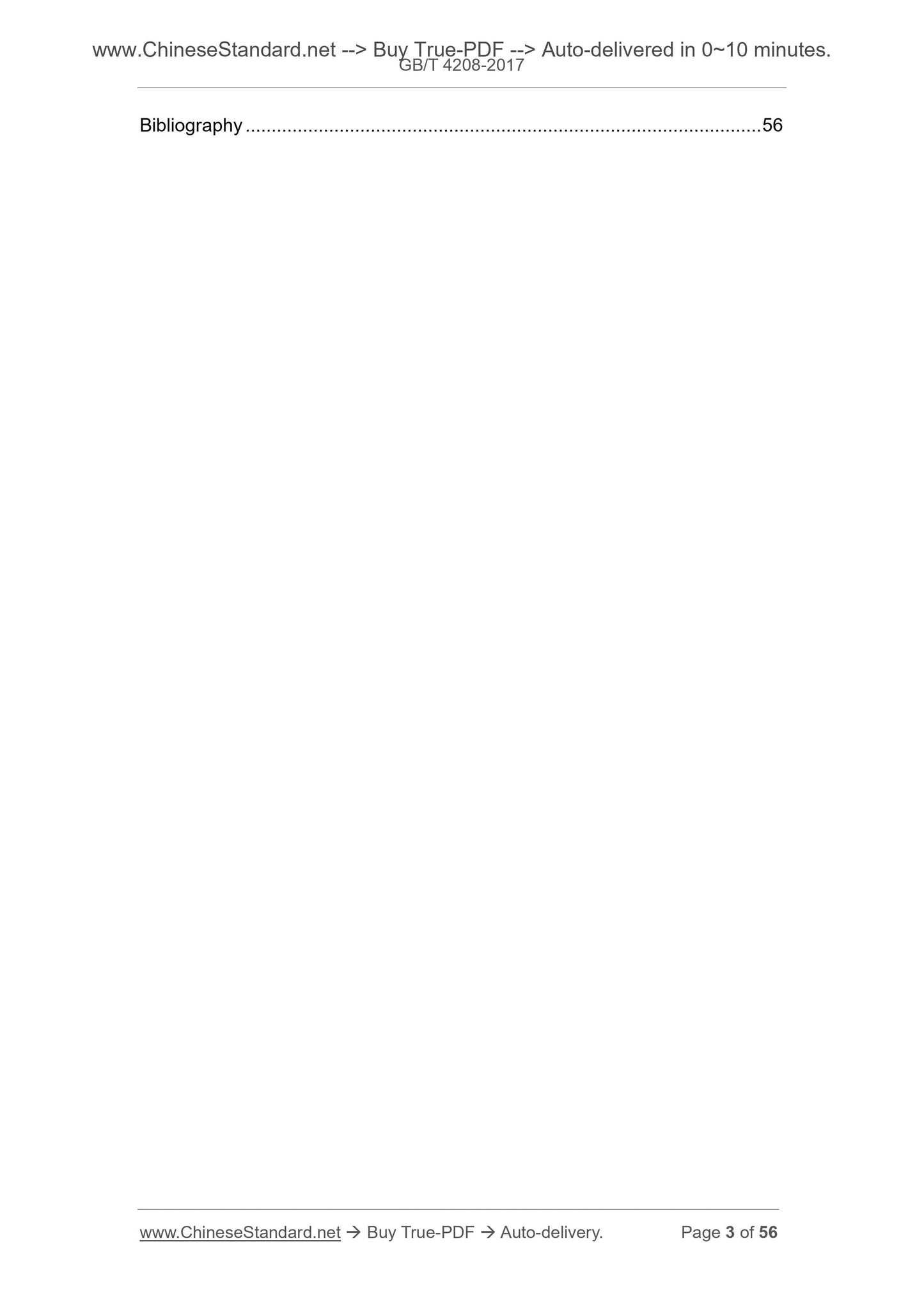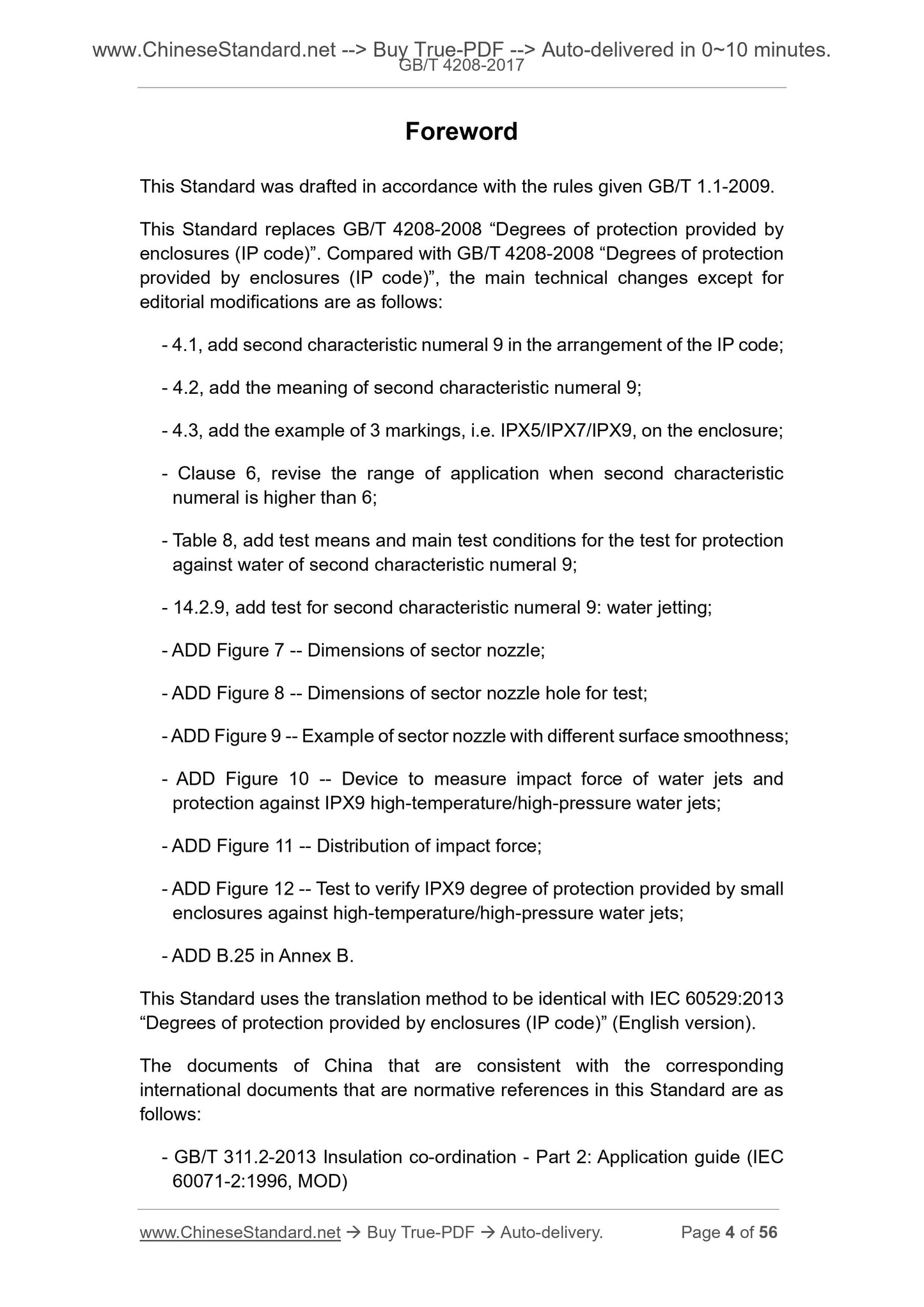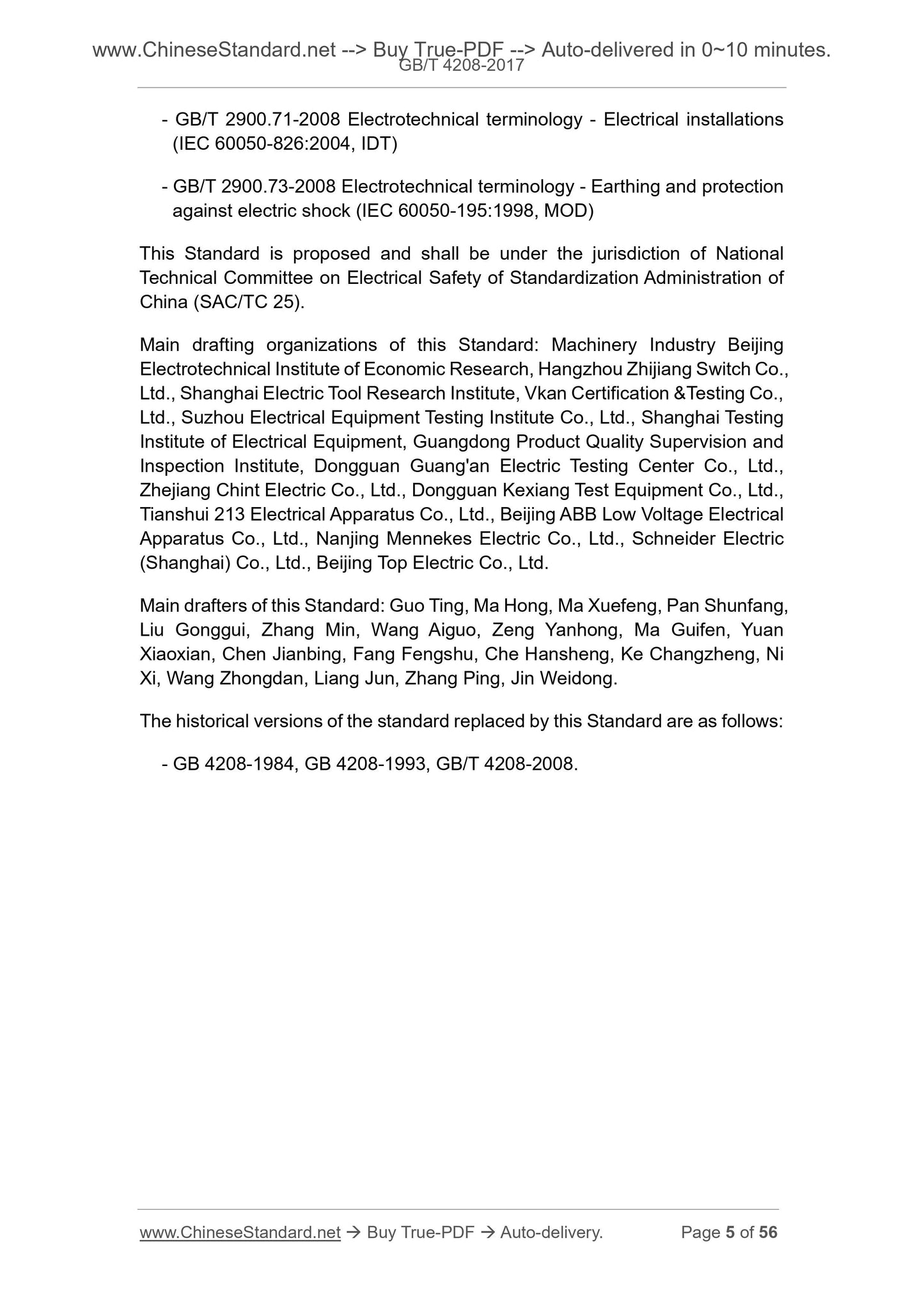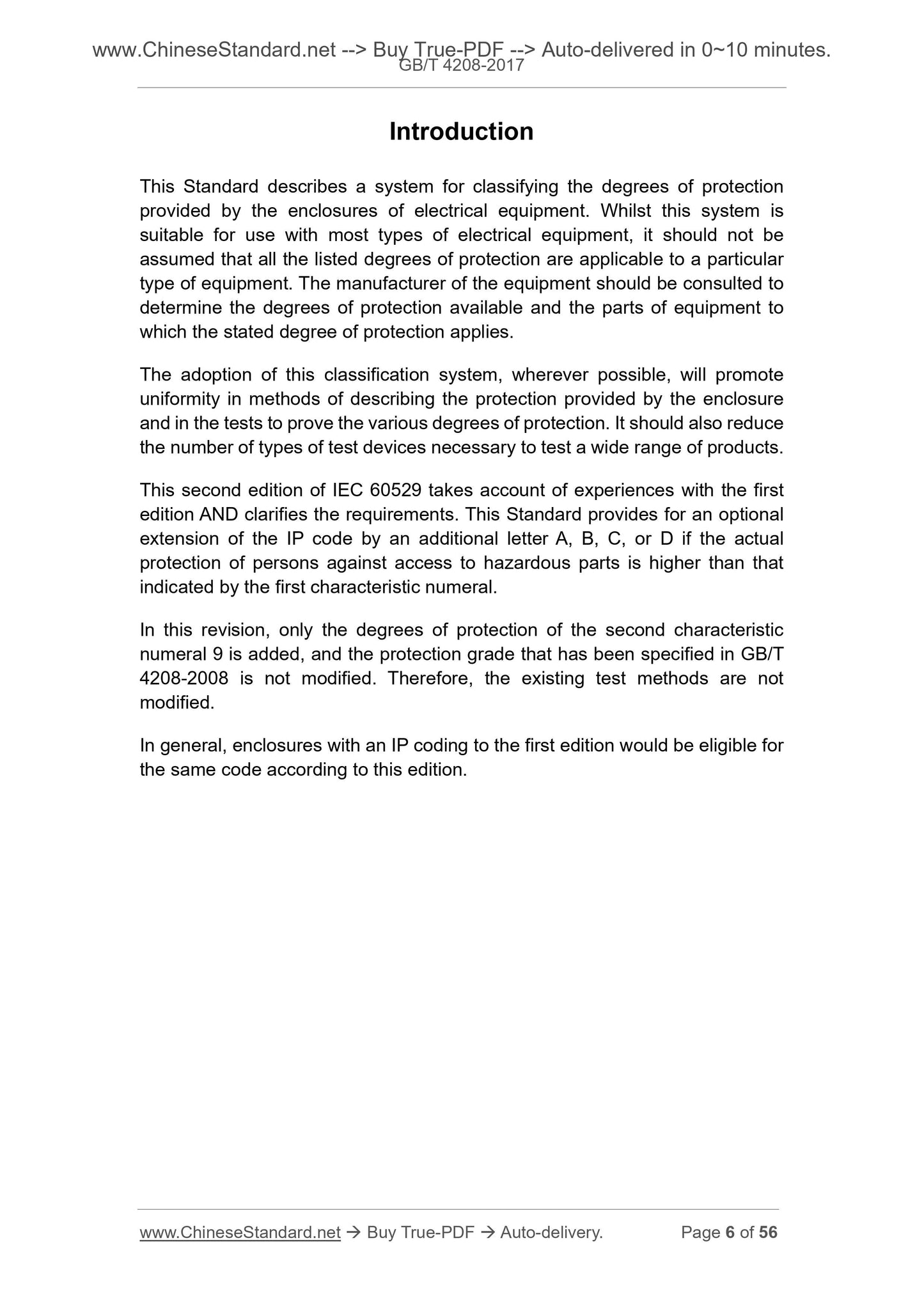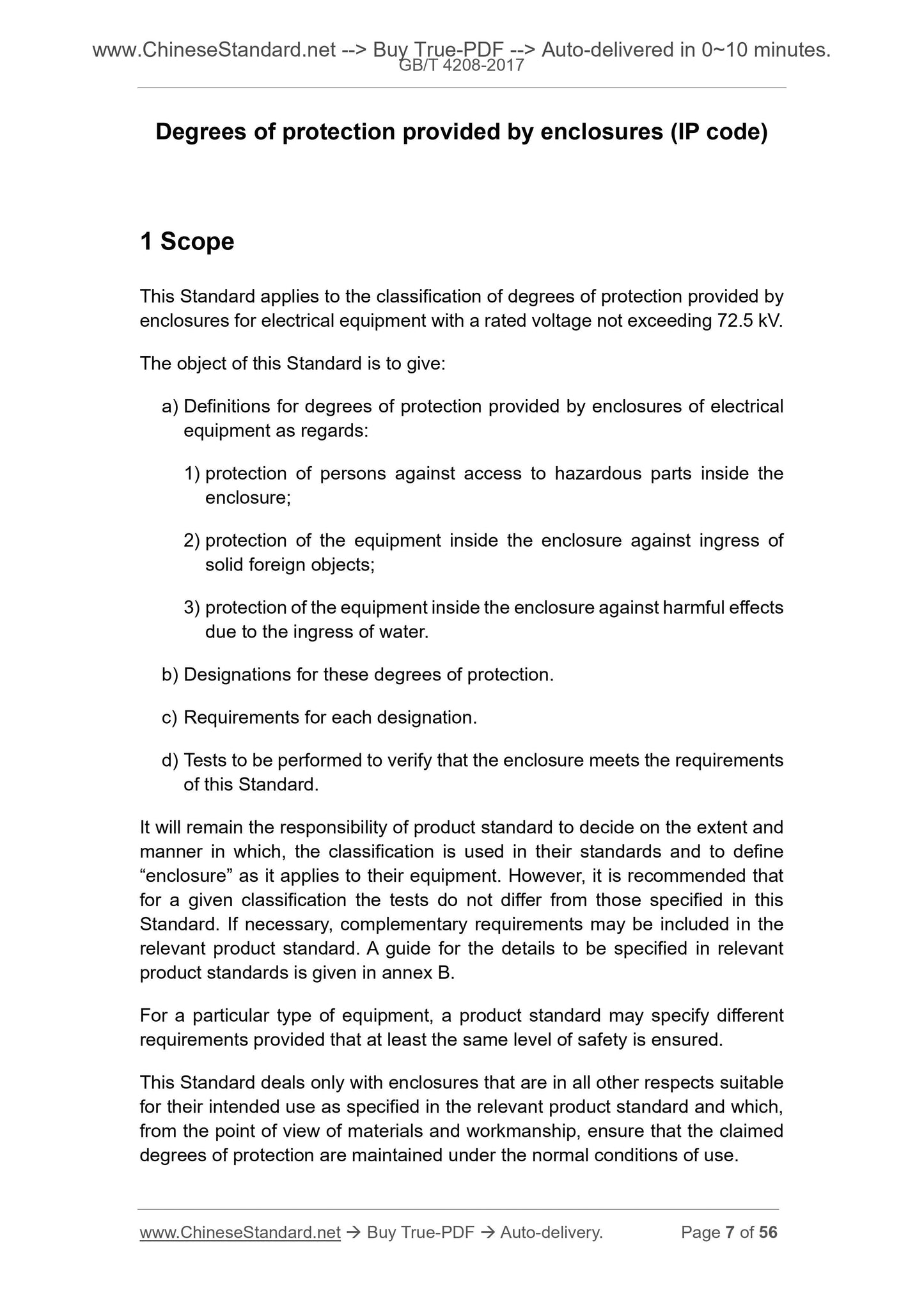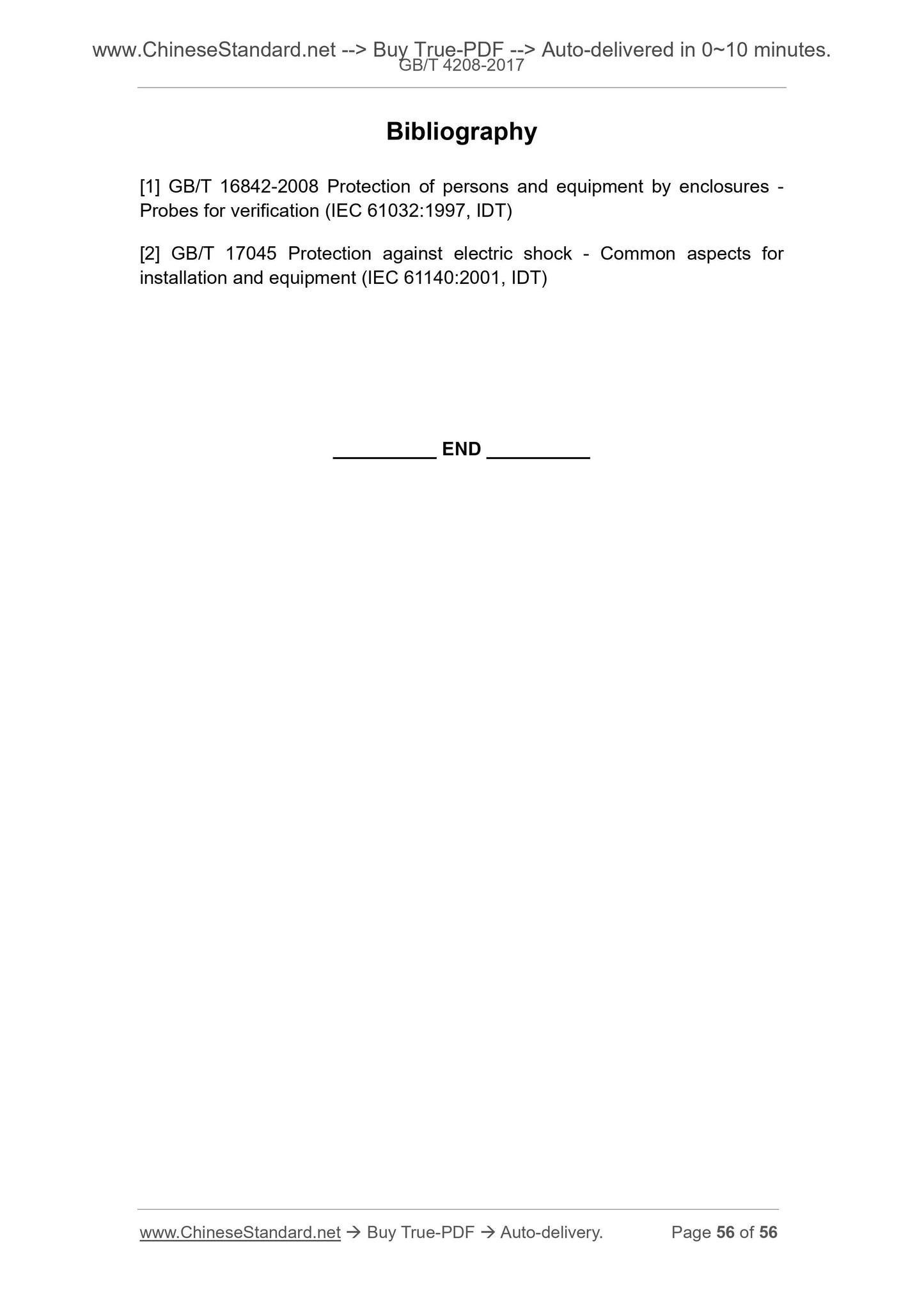1
/
of
9
www.ChineseStandard.us -- Field Test Asia Pte. Ltd.
GB/T 4208-2017 English PDF (GB/T4208-2017)
GB/T 4208-2017 English PDF (GB/T4208-2017)
Regular price
$155.00
Regular price
Sale price
$155.00
Unit price
/
per
Shipping calculated at checkout.
Couldn't load pickup availability
GB/T 4208-2017: [Including 2024XG1] Degrees of protection provided by enclosure (IP code)
Delivery: 9 seconds. Download (& Email) true-PDF + Invoice.
Get Quotation: Click GB/T 4208-2017 (Self-service in 1-minute)
Historical versions (Master-website): GB/T 4208-2017
Preview True-PDF (Reload/Scroll-down if blank)
GB/T 4208-2017
Degrees of protection provided by enclosure(IP code)
ICS 13.260
K09
National Standards of People's Republic of China
Replacing GB/T 4208-2008
Shell protection class (IP code)
(IEC 60529.2013, IDT)
Published on.2017-07-31
2018-02-01 Implementation
General Administration of Quality Supervision, Inspection and Quarantine of the People's Republic of China
China National Standardization Administration released
Foreword
This standard was drafted in accordance with the rules given in GB/T 1.1-2009.
This standard replaces GB/T 4208-2008 "Enclosure Protection Level (IP Code)"; this standard and GB/T 4208-2008 "Shell Protection
Compared with the grade (IP code), the main technical changes except the editorial modification are as follows.
---4.1, adding the second feature digit 9 to the IP code configuration;
---4.2, increase the meaning of the second characteristic number 9;
---4.3, an example of adding a 3-marker to the IPX5/IPX7/IPX9 shell;
--- Chapter 6, Revising the Application of the Second Feature Value Above 6;
--- Table 8, to increase the water resistance test method and main test conditions of the second characteristic number 9;
---14.2.9, increase the second characteristic number 9 water spray test;
--- Increase the size of Figure 7 --- fan nozzle;
--- Increase the size of Fig. 8 --- fan nozzle nozzle for testing;
--- Increased Figure 9 - Example of fan nozzles with different surface smoothness;
--- Addition of Figure 10 --- Measuring the impact of water spray, anti-IPX9 high temperature/high pressure water spray device;
--- Figure 11 --- impact force distribution;
--- Increased Figure 12 --- Inspection IPX9 protection grade of small enclosures, high temperature/high pressure water spray;
--- Add Appendix B B.25.
This standard uses the translation method equivalent to using IEC 60529.2013 "Enclosure Protection Level (IP code)" (English version).
The Chinese documents that have a consistent correspondence with the normatively cited international documents in this standard are as follows.
---GB/T 311.2-2013 Insulation coordination - Part 2. Guidelines for use (IEC 60071-2.1996, MOD)
---GB/T 2900.71-2008 Electrical Apparatus for Electrical Terms (IEC 60050-826.2004, IDT)
---GB/T 2900.73-2008 Electrical Terminology Grounding and Shock Protection (IEC 60050-195.1998, MOD)
This standard is proposed and managed by the National Electrical Safety Standardization Technical Committee (SAC/TC25).
This standard is mainly drafted by. Beijing Electrotechnical and Economic Research Institute of Machinery Industry, Hangzhou Zhijiang Switch Co., Ltd., Shanghai Electric
Tool Institute, Weikai Detection Technology Co., Ltd., Suzhou Electric Apparatus Research Institute Co., Ltd., Shanghai Electrical Equipment Inspection Institute, Guangdong
Quality Supervision and Inspection Institute, Dongguan Guang'an Electric Testing Center Co., Ltd., Zhejiang Zhengtai Electric Co., Ltd., Dongguan City Kexiang
Test Equipment Co., Ltd., Tianshui February 13 Electrical Appliance Co., Ltd., Beijing ABB Low Voltage Electrical Appliance Co., Ltd., Nanjing Mennekes Electric Appliance Co., Ltd.
Division, Schneider Electric (Shanghai) Co., Ltd., Beijing Breakthrough Electric Co., Ltd.
The main drafters of this standard. Guo Ting, Ma Hong, Ma Xuefeng, Pan Shunfang, Liu Gonggui, Zhang Min, Wang Aiguo, Zeng Yanhong, Ma Guifen, Yuan Xiaoyu,
Chen Jianbing, Fang Fengshu, Che Hansheng, Ke Changzheng, Ni Lan, Wang Zhongdan, Liang Jun, Zhang Ping, and Jin Weidong.
The previous versions of the standard replaced by this standard are.
--- GB 4208-1984, GB 4208-1993, GB/T 4208-2008.
introduction
This standard describes the rating system provided by the electrical equipment enclosure. Although this system is suitable for most types of electrical
Equipment, but not all types of protection are necessarily applied to specific types of electrical equipment. Manufacturers of equipment should be advised to determine the appropriate protection
Protect grades and apply equipment components of this grade.
The application of this grading system will make the narrative method and the corresponding level of test methods provided by the outer shell as uniform as possible. This
The wider range of products that will make the test equipment suitable will also reduce the number of test equipment required.
The second edition of IEC 60529 takes into account the experience of the first edition and clarifies the requirements. When actually preventing people from approaching dangerous parts
Above the level indicated by the first feature number, this standard provides optional extended ranges by appending the letters A, B, C, and D.
This revision only increases the protection level of the second characteristic number 9 and does not modify the degree of protection already specified in GB/T 4208-2008.
Therefore, the existing test methods are not modified.
In general, the shell labeled with an IP code in the previous version will fit the same level as this version.
Shell protection class (IP code)
1 Scope
This standard applies to rated voltage does not exceed 72.5kV, with the protection of electrical equipment protection class.
The purpose of this standard is as follows.
a) Enclosure protection rating for electrical equipment as follows.
1) Protection against human body touching dangerous parts inside the enclosure;
2) Protection against the entry of solid foreign matter into the equipment inside the enclosure;
3) Protection against harmful effects of water entering the enclosure.
b) Identification of the degree of protection.
c) Requirements for each level of protection marking.
d) Verification test of the shell according to the requirements of this standard.
The extent and manner of various types of products refer to the degree of protection of the enclosure, and what kind of enclosure is used, to be determined by product standards, and for specific protection
The tests used for the grades shall comply with the provisions of this standard, and additional requirements may be added to the relevant product standards when necessary. Can be in the relevant product standard
Refer to Appendix B for details of the specific provisions for quasi-in-China.
For special types of equipment, product standards can specify different requirements, but at least ensure the same level of safety.
This standard only considers enclosures that meet the requirements of relevant product standards in all aspects. Under normal conditions of use, the materials and processes of the enclosure should be
Ensure that the required degree of protection is achieved.
If a certain type of equipment meets the general requirements of the test and the selected degree of protection applies to the type of equipment, this standard also applies to this type of equipment.
Empty housing of type equipment.
Related to mechanical damage, rust, corrosive solvents (such as cutting fluids), molds, insect pests, solar radiation, icing, moisture (as caused by condensation), explosions
Explosive gas and other external influences or environmental conditions to prevent damage to the equipment in the enclosure and enclosure and to prevent external moving parts with the enclosure
The contact (eg fan) is regulated by the relevant product standard.
Partitions that are not connected to the enclosure and barriers that are specifically designed for personal safety are not considered as part of the enclosure and are not studied in this standard.
2 Normative references
The following documents are indispensable for the application of this document. For dated references, only dated versions apply to this article
Pieces. For undated references, the latest version (including all amendments) applies to this document.
GB/T 2421.1-2008 Overview and Guide for Environmental Testing of Electrical and Electronic Products (IEC 60068-1.1988, IDT)
GB/T 2423.37-2006 Environmental testing for electric and electronic products Part 2. Test methods Test L. Sand dust test
(IEC 60068-2-68.1994, IDT)
IEC 60050-195..1998 International Electrotechnical Terminology, Part 195. Grounding and electric shock protection
IEC 60050(826).1982 International Electrotechnical Term 826. Electrical Installations for Buildings
IEC 60071-2.1996 Insulation coordination - Part 2. Guidelines for use
3 Terms and Definitions
The following terms and definitions apply to this document.
3.1
Enclosure
Devices that prevent the device from being exposed to certain external influences and that prevent direct contact in all directions.
Note. This definition is taken from the current International Electrotechnical Vocabulary (IEV) and is explained within the scope of this standard as follows.
1) The enclosure provides protection of the person or animal from the hazardous parts inside the enclosure.
2) Preventing or limiting the entry of partitions, openings or other openings in the test equipment specified in this standard, whether attached to the outer shell or sheathed
Prepared, are counted as part of the shell, except the parts can be removed without the use of keys or tools.
[IEC 826-03-12]
3.2
Direct contact with directcontact
Human or animal contact with live parts.
Note. According to the information given in the IEV definition, "direct contact" in this standard is replaced by "close to dangerous parts".
[IEC 826-03-05]
3.3
Protection degree degreeofprotection
According to the inspection method specified in the standard, the protection provided by the enclosure to the person near the dangerous part, the prevention of the entry of solid foreign matter or the entry of water shall be determined.
degree.
3.4
IP code IPcode
Indicates the degree of protection of the enclosure from access to hazardous parts, prevention of the entry of solid foreign matter or water, and gives additional protection related to these protections
Information code system.
3.5
Hazardouspart hazardous part
Parts that are dangerous when approaching or touching.
3.5.1
Hazardous live parts hazardouslivelivepart
A charged part that can cause a harmful electrical shock under certain conditions.
[IEC 60050-195, definition 195-06-05]
3.5.2
Hazardous mechanical parts
Contact with dangerous moving parts. Except smooth rotating axis.
3.6
Housing protection against dangerous parts protectionprovidedbyanenclosureagainstaccesstohazardousparts
Shell to human body.
--- Protection from contact with dangerous low-voltage live parts;
--- Protection from contact with dangerous mechanical parts;
--- Prevents dangerous high-voltage live parts from being exposed if there is not enough room inside the enclosure.
Note. This protection can be assisted by.
--- Shell itself;
--- The baffle that is part of the enclosure or is achieved by means of the distance within the enclosure.
3.7
Prevent enough gaps close to dangerous parts adequateclearanceforprotectionagainstaccesstohazardousparts
Prevents touching the test tool to or near the dangerous part.
3.8
Touch the test tool accessprobe
Can easily imitate a part of the human body or imitate a tool or the like, hand held by the person to check whether there is enough clearance from the dangerous part
Inspection tools.
3.9
Object test object object
An inspection tool that simulates the detection of solid foreign matter and its possibility of entering the enclosure.
3.10
Opening
The holes or crevices that are present in the enclosure itself or that have been imposed by the test tool with a defined external force.
4 Identification
The degree of protection provided by the enclosure is indicated in the following manner using the IP code.
4.1 Configuration of IP Codes
IP 2 3 CH
Code letter
(International Protection)
First feature number
(number 0~6 or letter)
Second feature number
(numbers 0-9 or letters)
Additional letter
(letters A, B, C, D)
Supplementary letter
(The letters H, M, S, W)
When it is not required to specify a feature number, it is replaced by the letter "X" (if both letters are omitted, "XX" is used).
Additional letters and/or supplementary letters can be omitted without replacement.
When more than one supplemental letter is used, they should be arranged alphabetically.
When the housing uses different mounting methods to provide different degrees of protection, the manufacturer shall indicate the protection against the corresponding installation instructions.
Protection level.
See Chapter 10 for details of the shell logo method.
4.2 Elements of the IP Code and Their Meanings
A brief description of each element of the IP code is given in the table below. For details, see the section indicated in the last column of the table.
Composition Numbers or Letters Meaning of Device Protection Meaning of Personnel Protection Reference Chapter
Code letter
The first one
Feature number
IP
Prevent the entry of solid foreign matter
No protection
≥ diameter 50mm
≥ diameter 12.5mm
≥ diameter 2.5mm
≥ diameter 1.0mm
dust-proof
Dense
Prevents access to dangerous parts
No protection
Hand back
finger
tool
metal wire
metal wire
metal wire
Chapter 5
second
Feature number
Additional letter
(optional)
Supplementary letter
(optional)
Prevent harmful effects of water ingress
No protection
Vertical drip
15° drop of water
Watering
Splashing water
Water spray
Violent water spray
Short time soaking
Continuous water immersion
High temperature/high pressure water jet
Specially supplemented information
High-voltage equipment
Test run when waterproof test
Static test specimen when making waterproof test
Climatic conditions
Prevents access to dangerous parts
Hand back
finger
tool
metal wire
Chapter 6
Chapter 7
Chapter 8
4.3 IP Code Application Examples
The following is an example of IP code application and letter configuration. See Chapter 9 for more examples.
IP44 - no additional letters, no optional letters.
IPX5 --- omitted the first feature number.
IP2X --- omit the second feature number.
IP20C---Use additional letters.
IPXXC --- omits ...
Delivery: 9 seconds. Download (& Email) true-PDF + Invoice.
Get Quotation: Click GB/T 4208-2017 (Self-service in 1-minute)
Historical versions (Master-website): GB/T 4208-2017
Preview True-PDF (Reload/Scroll-down if blank)
GB/T 4208-2017
Degrees of protection provided by enclosure(IP code)
ICS 13.260
K09
National Standards of People's Republic of China
Replacing GB/T 4208-2008
Shell protection class (IP code)
(IEC 60529.2013, IDT)
Published on.2017-07-31
2018-02-01 Implementation
General Administration of Quality Supervision, Inspection and Quarantine of the People's Republic of China
China National Standardization Administration released
Foreword
This standard was drafted in accordance with the rules given in GB/T 1.1-2009.
This standard replaces GB/T 4208-2008 "Enclosure Protection Level (IP Code)"; this standard and GB/T 4208-2008 "Shell Protection
Compared with the grade (IP code), the main technical changes except the editorial modification are as follows.
---4.1, adding the second feature digit 9 to the IP code configuration;
---4.2, increase the meaning of the second characteristic number 9;
---4.3, an example of adding a 3-marker to the IPX5/IPX7/IPX9 shell;
--- Chapter 6, Revising the Application of the Second Feature Value Above 6;
--- Table 8, to increase the water resistance test method and main test conditions of the second characteristic number 9;
---14.2.9, increase the second characteristic number 9 water spray test;
--- Increase the size of Figure 7 --- fan nozzle;
--- Increase the size of Fig. 8 --- fan nozzle nozzle for testing;
--- Increased Figure 9 - Example of fan nozzles with different surface smoothness;
--- Addition of Figure 10 --- Measuring the impact of water spray, anti-IPX9 high temperature/high pressure water spray device;
--- Figure 11 --- impact force distribution;
--- Increased Figure 12 --- Inspection IPX9 protection grade of small enclosures, high temperature/high pressure water spray;
--- Add Appendix B B.25.
This standard uses the translation method equivalent to using IEC 60529.2013 "Enclosure Protection Level (IP code)" (English version).
The Chinese documents that have a consistent correspondence with the normatively cited international documents in this standard are as follows.
---GB/T 311.2-2013 Insulation coordination - Part 2. Guidelines for use (IEC 60071-2.1996, MOD)
---GB/T 2900.71-2008 Electrical Apparatus for Electrical Terms (IEC 60050-826.2004, IDT)
---GB/T 2900.73-2008 Electrical Terminology Grounding and Shock Protection (IEC 60050-195.1998, MOD)
This standard is proposed and managed by the National Electrical Safety Standardization Technical Committee (SAC/TC25).
This standard is mainly drafted by. Beijing Electrotechnical and Economic Research Institute of Machinery Industry, Hangzhou Zhijiang Switch Co., Ltd., Shanghai Electric
Tool Institute, Weikai Detection Technology Co., Ltd., Suzhou Electric Apparatus Research Institute Co., Ltd., Shanghai Electrical Equipment Inspection Institute, Guangdong
Quality Supervision and Inspection Institute, Dongguan Guang'an Electric Testing Center Co., Ltd., Zhejiang Zhengtai Electric Co., Ltd., Dongguan City Kexiang
Test Equipment Co., Ltd., Tianshui February 13 Electrical Appliance Co., Ltd., Beijing ABB Low Voltage Electrical Appliance Co., Ltd., Nanjing Mennekes Electric Appliance Co., Ltd.
Division, Schneider Electric (Shanghai) Co., Ltd., Beijing Breakthrough Electric Co., Ltd.
The main drafters of this standard. Guo Ting, Ma Hong, Ma Xuefeng, Pan Shunfang, Liu Gonggui, Zhang Min, Wang Aiguo, Zeng Yanhong, Ma Guifen, Yuan Xiaoyu,
Chen Jianbing, Fang Fengshu, Che Hansheng, Ke Changzheng, Ni Lan, Wang Zhongdan, Liang Jun, Zhang Ping, and Jin Weidong.
The previous versions of the standard replaced by this standard are.
--- GB 4208-1984, GB 4208-1993, GB/T 4208-2008.
introduction
This standard describes the rating system provided by the electrical equipment enclosure. Although this system is suitable for most types of electrical
Equipment, but not all types of protection are necessarily applied to specific types of electrical equipment. Manufacturers of equipment should be advised to determine the appropriate protection
Protect grades and apply equipment components of this grade.
The application of this grading system will make the narrative method and the corresponding level of test methods provided by the outer shell as uniform as possible. This
The wider range of products that will make the test equipment suitable will also reduce the number of test equipment required.
The second edition of IEC 60529 takes into account the experience of the first edition and clarifies the requirements. When actually preventing people from approaching dangerous parts
Above the level indicated by the first feature number, this standard provides optional extended ranges by appending the letters A, B, C, and D.
This revision only increases the protection level of the second characteristic number 9 and does not modify the degree of protection already specified in GB/T 4208-2008.
Therefore, the existing test methods are not modified.
In general, the shell labeled with an IP code in the previous version will fit the same level as this version.
Shell protection class (IP code)
1 Scope
This standard applies to rated voltage does not exceed 72.5kV, with the protection of electrical equipment protection class.
The purpose of this standard is as follows.
a) Enclosure protection rating for electrical equipment as follows.
1) Protection against human body touching dangerous parts inside the enclosure;
2) Protection against the entry of solid foreign matter into the equipment inside the enclosure;
3) Protection against harmful effects of water entering the enclosure.
b) Identification of the degree of protection.
c) Requirements for each level of protection marking.
d) Verification test of the shell according to the requirements of this standard.
The extent and manner of various types of products refer to the degree of protection of the enclosure, and what kind of enclosure is used, to be determined by product standards, and for specific protection
The tests used for the grades shall comply with the provisions of this standard, and additional requirements may be added to the relevant product standards when necessary. Can be in the relevant product standard
Refer to Appendix B for details of the specific provisions for quasi-in-China.
For special types of equipment, product standards can specify different requirements, but at least ensure the same level of safety.
This standard only considers enclosures that meet the requirements of relevant product standards in all aspects. Under normal conditions of use, the materials and processes of the enclosure should be
Ensure that the required degree of protection is achieved.
If a certain type of equipment meets the general requirements of the test and the selected degree of protection applies to the type of equipment, this standard also applies to this type of equipment.
Empty housing of type equipment.
Related to mechanical damage, rust, corrosive solvents (such as cutting fluids), molds, insect pests, solar radiation, icing, moisture (as caused by condensation), explosions
Explosive gas and other external influences or environmental conditions to prevent damage to the equipment in the enclosure and enclosure and to prevent external moving parts with the enclosure
The contact (eg fan) is regulated by the relevant product standard.
Partitions that are not connected to the enclosure and barriers that are specifically designed for personal safety are not considered as part of the enclosure and are not studied in this standard.
2 Normative references
The following documents are indispensable for the application of this document. For dated references, only dated versions apply to this article
Pieces. For undated references, the latest version (including all amendments) applies to this document.
GB/T 2421.1-2008 Overview and Guide for Environmental Testing of Electrical and Electronic Products (IEC 60068-1.1988, IDT)
GB/T 2423.37-2006 Environmental testing for electric and electronic products Part 2. Test methods Test L. Sand dust test
(IEC 60068-2-68.1994, IDT)
IEC 60050-195..1998 International Electrotechnical Terminology, Part 195. Grounding and electric shock protection
IEC 60050(826).1982 International Electrotechnical Term 826. Electrical Installations for Buildings
IEC 60071-2.1996 Insulation coordination - Part 2. Guidelines for use
3 Terms and Definitions
The following terms and definitions apply to this document.
3.1
Enclosure
Devices that prevent the device from being exposed to certain external influences and that prevent direct contact in all directions.
Note. This definition is taken from the current International Electrotechnical Vocabulary (IEV) and is explained within the scope of this standard as follows.
1) The enclosure provides protection of the person or animal from the hazardous parts inside the enclosure.
2) Preventing or limiting the entry of partitions, openings or other openings in the test equipment specified in this standard, whether attached to the outer shell or sheathed
Prepared, are counted as part of the shell, except the parts can be removed without the use of keys or tools.
[IEC 826-03-12]
3.2
Direct contact with directcontact
Human or animal contact with live parts.
Note. According to the information given in the IEV definition, "direct contact" in this standard is replaced by "close to dangerous parts".
[IEC 826-03-05]
3.3
Protection degree degreeofprotection
According to the inspection method specified in the standard, the protection provided by the enclosure to the person near the dangerous part, the prevention of the entry of solid foreign matter or the entry of water shall be determined.
degree.
3.4
IP code IPcode
Indicates the degree of protection of the enclosure from access to hazardous parts, prevention of the entry of solid foreign matter or water, and gives additional protection related to these protections
Information code system.
3.5
Hazardouspart hazardous part
Parts that are dangerous when approaching or touching.
3.5.1
Hazardous live parts hazardouslivelivepart
A charged part that can cause a harmful electrical shock under certain conditions.
[IEC 60050-195, definition 195-06-05]
3.5.2
Hazardous mechanical parts
Contact with dangerous moving parts. Except smooth rotating axis.
3.6
Housing protection against dangerous parts protectionprovidedbyanenclosureagainstaccesstohazardousparts
Shell to human body.
--- Protection from contact with dangerous low-voltage live parts;
--- Protection from contact with dangerous mechanical parts;
--- Prevents dangerous high-voltage live parts from being exposed if there is not enough room inside the enclosure.
Note. This protection can be assisted by.
--- Shell itself;
--- The baffle that is part of the enclosure or is achieved by means of the distance within the enclosure.
3.7
Prevent enough gaps close to dangerous parts adequateclearanceforprotectionagainstaccesstohazardousparts
Prevents touching the test tool to or near the dangerous part.
3.8
Touch the test tool accessprobe
Can easily imitate a part of the human body or imitate a tool or the like, hand held by the person to check whether there is enough clearance from the dangerous part
Inspection tools.
3.9
Object test object object
An inspection tool that simulates the detection of solid foreign matter and its possibility of entering the enclosure.
3.10
Opening
The holes or crevices that are present in the enclosure itself or that have been imposed by the test tool with a defined external force.
4 Identification
The degree of protection provided by the enclosure is indicated in the following manner using the IP code.
4.1 Configuration of IP Codes
IP 2 3 CH
Code letter
(International Protection)
First feature number
(number 0~6 or letter)
Second feature number
(numbers 0-9 or letters)
Additional letter
(letters A, B, C, D)
Supplementary letter
(The letters H, M, S, W)
When it is not required to specify a feature number, it is replaced by the letter "X" (if both letters are omitted, "XX" is used).
Additional letters and/or supplementary letters can be omitted without replacement.
When more than one supplemental letter is used, they should be arranged alphabetically.
When the housing uses different mounting methods to provide different degrees of protection, the manufacturer shall indicate the protection against the corresponding installation instructions.
Protection level.
See Chapter 10 for details of the shell logo method.
4.2 Elements of the IP Code and Their Meanings
A brief description of each element of the IP code is given in the table below. For details, see the section indicated in the last column of the table.
Composition Numbers or Letters Meaning of Device Protection Meaning of Personnel Protection Reference Chapter
Code letter
The first one
Feature number
IP
Prevent the entry of solid foreign matter
No protection
≥ diameter 50mm
≥ diameter 12.5mm
≥ diameter 2.5mm
≥ diameter 1.0mm
dust-proof
Dense
Prevents access to dangerous parts
No protection
Hand back
finger
tool
metal wire
metal wire
metal wire
Chapter 5
second
Feature number
Additional letter
(optional)
Supplementary letter
(optional)
Prevent harmful effects of water ingress
No protection
Vertical drip
15° drop of water
Watering
Splashing water
Water spray
Violent water spray
Short time soaking
Continuous water immersion
High temperature/high pressure water jet
Specially supplemented information
High-voltage equipment
Test run when waterproof test
Static test specimen when making waterproof test
Climatic conditions
Prevents access to dangerous parts
Hand back
finger
tool
metal wire
Chapter 6
Chapter 7
Chapter 8
4.3 IP Code Application Examples
The following is an example of IP code application and letter configuration. See Chapter 9 for more examples.
IP44 - no additional letters, no optional letters.
IPX5 --- omitted the first feature number.
IP2X --- omit the second feature number.
IP20C---Use additional letters.
IPXXC --- omits ...
Share
